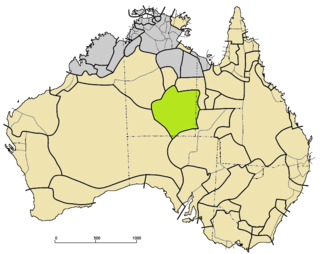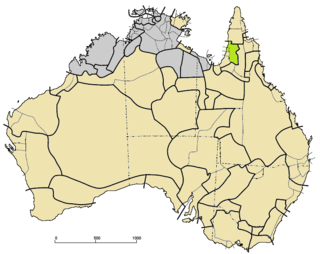Related Research Articles
Guugu Yimithirr, also rendered Guugu Yimidhirr, Guguyimidjir, and many other spellings, is an Australian Aboriginal language, the traditional language of the Guugu Yimithirr people of Far North Queensland. It belongs to the Pama-Nyungan language family. Most of the speakers today live at the community of Hope Vale, about 46 kilometres (29 mi) from Cooktown. However, as of June 2020 only about half of the Guugu Yimithirr nation speak the language. As such, efforts are being made to teach it to children. Guugu Yimithirr is the source language of the word kangaroo.

Kowanyama is a town and coastal locality in the Aboriginal Shire of Kowanyama, Queensland, Australia.

Pormpuraaw is a coastal town and a locality in the Aboriginal Shire of Pormpuraaw, Queensland, Australia. Pormpuraaw is an Aboriginal community situated on the west coast of Cape York Peninsula approximately halfway between Karumba and Weipa on the Edward River. It is 650 kilometres (400 mi) by road from Cairns. Pormpuraaw currently has a 4-man police station.

Arrernte or Aranda or sometimes referred to as Upper Arrernte, is a dialect cluster in the Arandic language group spoken in parts of the Northern Territory, Australia, by the Arrernte people. Other spelling variations are Arunta or Arrarnta, and all of the dialects have multiple other names.

The Paman languages are an Australian language family spoken on Cape York Peninsula, Queensland. First noted by Kenneth Hale, Paman is noteworthy for the profound phonological changes which have affected some of its descendants.

The Shire of Cook is a local government area in Far North Queensland, Australia. The Shire covers most of the eastern and central parts of Cape York Peninsula, the most northerly section of the Australian mainland.
Kunjen, or Uw, is a Paman language spoken on the Cape York Peninsula of Queensland, Australia, by the Uw Oykangand, Olkola, and related Aboriginal Australian peoples. It is closely related to Kuuk Thaayorre, and perhaps Kuuk Yak.

The Aboriginal Shire of Kowanyama is a special local government area which is located on western Cape York Peninsula in Queensland, Australia. It is managed under a Deed of Grant in Trust under the Local Government Act 2004.

The Aboriginal Shire of Pormpuraaw is a special local government area which is located on western Cape York Peninsula in Queensland, Australia. It is managed under a Deed of Grant in Trust under the Local Government Act 2004.
Kuuk Thaayorre (Thayore) is a Paman language spoken in the settlement Pormpuraaw on the western part of the Cape York Peninsula, Queensland in Australia by the Thaayorre people. As of 2006, 250 of the 350 ethnic Thaayorre spoke the language. It is in a robust position compared to many indigenous Australian languages, as it is still being acquired by children and used in daily interaction.
Yirrk-Thangalkl is a dialect of Yir-Yoront, a Paman language spoken on the southwestern part of the Cape York Peninsula, Queensland in Australia, by the Yirrk-Thangalkl people. The language is also known as Yirr-Thangell and Yirrk-Mel.

The Southwestern Paman languages are a family of the Paman languages spoken on the western part of the Cape York Peninsula of Queensland, Australia.
The Yir-Yoront, also known as the Yir Yiront, are an Indigenous Australian people of the Cape York Peninsula now living mostly in Kowanyama but also in Lirrqar/Pormpuraaw, both towns outside their traditional lands.
The Thaayorre, or Kuuk Thaayore, are an Australian people living on the southwestern part of the Cape York Peninsula, Queensland in Australia, primarily in the settlement Pormpuraaw, having its foundation in the Edward River Mission.
The Uw Oykangand, otherwise known as the Kwantari, are an Aboriginal Australian people living on the southwestern part of the Cape York Peninsula, in the state of Queensland in Australia. Their neighbours to the northwest are the Yir-Yoront people. Their traditional lands are around the Alice River and the Crosbie River, and further west around the Mitchell River and into Gulf Country.
Kuuk Yak, or the snake language, if translated literally, is an extinct Paman language which was spoken on the Cape York Peninsula of Queensland, Australia.

Kaytetye is an Australian Aboriginal language primarily spoken in the Northern Territory north of Alice Springs by the Kaytetye people, who live around Barrow Creek and Tennant Creek. It belongs to the Arandic subgroup of the Pama-Nyungan languages and is related to Alyawarra, which is one of the Upper Arrernte dialects. It has an unusual phonology and there are no known dialects.
Ayabadhu (Ayapathu), or Badhu, is an extinct Australian Aboriginal language of the Paman family spoken on the Cape York Peninsula of North Queensland, Australia by the Ayapathu people. The Ayabadhu language region includes the Cook Shire and the areas around Coen and Port Stewart.
The Kokangol (Koko-Gol), or Yuwula, are said to have been an Indigenous Australian people of Queensland. Some dispute this, suggesting the name may be a synonym for Aghu Tharnggala, or may simply be the name of a language consultant.
The Ajabakan were an indigenous Australian people of the Cape York Peninsula of Queensland.
References
Notes
- 1 2 Y72 Yir Yoront at the Australian Indigenous Languages Database, Australian Institute of Aboriginal and Torres Strait Islander Studies (see the info box for additional links)
- ↑ Ethnologue
- ↑ Gaby, Alice Rose (2006). A Grammar of Kuuk Thaayorre. p. 6.
- ↑ Moseley, Christopher (ed.). 2010. Atlas of the World’s Languages in Danger, 3rd edn. Paris, UNESCO Publishing. Online version: http://www.unesco.org/culture/en/endangeredlanguages/atlas
- ↑ Alpher, Barry (1991). Yir-Yoront Lexicon: Sketch and Dictionary of an Australian Language. p. 3.
- ↑ Kendon, A. (1988) Sign Languages of Aboriginal Australia: Cultural, Semiotic and Communicative Perspectives. Cambridge: Cambridge University Press
General
- Alpher, Barry (1991). Yir-Yoront lexicon: Sketch and dictionary of an Australian language. Berlin: Mouton de Gruyter.